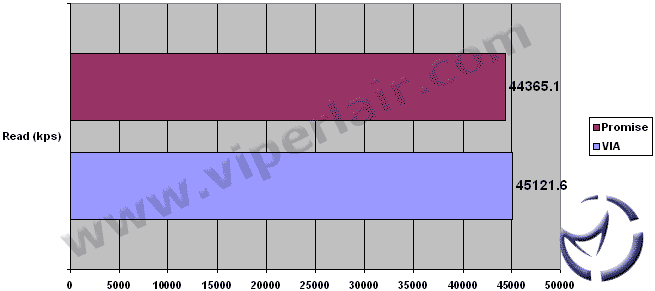Subsystem Testing
The first thing we'll check is the audio. We downloaded and installed to test its CPU utilization.
CPU utilization wasn't terribly high thoughout the DirectSound3D tests using the ADI AD1980. CPU utilization never got to 8%, but it did average in the 4% - 6% range, which is a lot higher than the <2% averages we've seen with the nForce 2.
It's not the end of the world, given that the slowest CPU you would be using with the K8V is an Athlon 64 3200+, but we would have liked to have seen lower numbers. This is a synthetic benchmark though, and since I know all of you enjoy a game or two, let's see how the sound will affect UT 2003 performance.
UT 2003 Antalus Sound Tests
For our UT2003 tests, we ran dm-Antalus benchmarks at 640x480, minimum detail with sound on and off. This was repeated at 1024x768, but with maximum detail. The reasoning is at low detail and resolution, the work will fall on the CPU and motherboard subsystem. Higher resolution is more representive of actual gameplay for most users, and put more work on the video card.

With sound enabled, the ASUS K8V Deluxe takes ~5.5 frames per second hit at 640x480. These results are a little better than what we've seen with Realtek ALC650 solutions. At 1024x768, there wasn't much of a drop at all, losing only about a quarter of a frame.
In terms of sound quality, I found gaming to be very acceptable, as was the case with movie and MP3 playback. There was almost no distortion when running disk intensive tasks, unless I played a MP3 file off the same drive I was defragmenting.
For recording tests, I used a small microphone that came with my Audigy Platinum, and recorded a few sentences. The recordings sounded as they should, with only slight distortion. Sound quality was slightly muffled at default driver settings, but with some tweaks done via the sound software, the sound quality was improved. I still wouldn't use it for professional level recordings though.
Hard Drive Performance
We used HD Tach to gauge read and write performance with our Western Digital SE 120GB HDD, and read performance with our Seagate 120GB SATA drive. Unfortunently, I don't have an identical drives to perform RAID testing, but we'll try to follow this up when I can acquire a second drive.
Tests were done using freshly imaged disks, split into partitions of 40GB, 50GB, 30GB (roughly), and benched on both the VIA and Promise controllers.
PATA Performance

As with the K8T, we witnessed the Promise controller outperforming the VIA controller. As before, the Promise controller does edge out the VIA in CPU usage, eating 17.3%, compared to VIA's 18.9%.
SATA Performance

On the VIA controller, the maximum read speed with the Seagate SATA drive was about 61MB/sec, with 45MB/sec being the average. CPU usage was 19.5%, similar to PATA performance. The Promise averaged a slightly lower read speed, but the CPU usage was also lower at 17.1%.



